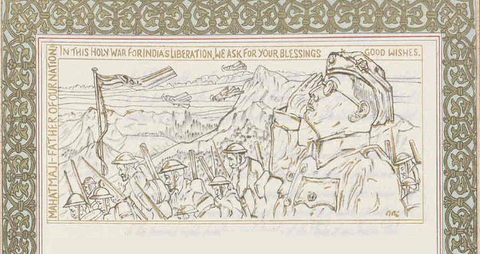In 1947, India gained its hard-fought independence, but this was just one step towards building a robust nation. Among the other critical steps, the drafting of the Constitution emerged as a poignant undertaking. Visionary leaders including, Dr. B.R. Ambedkar, N. Gopalswami, and K.M. Munshi devoted nearly years to shaping this fundamental document. Post-drafting, a decision was made not just to manually write but also to illustrate them, ensuring that the Constitution was not only a legal document but also a work of art reflecting the country's rich heritage.
Consequently, a gifted artist from Shantiniketan, Nandalal Bose, and his team of students, were entrusted with the duty of creating painted pieces and sketches for this integral text. Among this talented group were five women artists—Gauri Bhanja, Jamuna Sen, Amala Sarkar, Nibedita Bose, and Bani Patel, each leaving their mark on the historic endeavour. Their artistic endeavour was to visually encapsulate the highest principles as well as aspirations of new India. Thus began the journey of crafting the world's largest constitution.
Another artist from a family of calligraphers- Prem Bihari Riazada, devoted his time and effort to craft the longest handwritten Constitution in English, while the Hindi version was calligraphed by Vasant Krishan Vaidya. This collective endeavour between the drafters and artists deserves to be commemorated time and again. The entire process, including drafting, drafting, writing, and illustrating, spanned a total of 5 years.
Notably, the Indian artists have drawn inspiration from various sources, including the ornate designs of Ajanta and Bagh Caves, quintessentially oriental Chola art, as well as Deccani miniature, and poster art of 19th and 20th century India. Each of the 22 chapters commences with one or two illustrations, providing a distinctive perspective. The illustrations are placed in chronological order, starting from the first civilisation of India - the Indus Valley Civilization, moving to the struggle for independence.
List of Illustrations in the Constitution
Front cover of the constitution
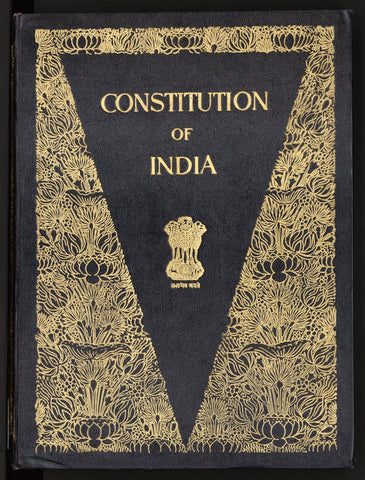
The cover page of the Constituton bears the National emblem and an orderly arrangement of flowers forming a V-shape.
The cover page of the Constituton bears the National emblem and an orderly arrangement of flowers forming a V-shape. The image of lotuses should not be mistaken as a political symbol. Blooming lotuses have been a common recurring symbol in Hinduism, Buddhism and Jainism. It would be more appropriate to see these blooming lotuses as a representation of a country rising from its past.
Let us explore and decode these thought-provoking artworks within the Indian Constitution:
1. The Emblem:

National Emblem
The constitution of India begins with the National Emblem, acquired from the Mauryan Emperor Ashoka’s famous Lion Capital at Sarnath and is a symbol of pride. The emblem bears 4 lions and a Dharma Chakra. The 4 Lions symbolise 4 noble truths in Buddhism- life is suffering, the cause of suffering/ dukkha is desire and greed, the solution to dukkha is detachment, and finally the practice of 8-fold path to be at peace.The lion capital is placed on a pedestal, which depicts the wheel also famously known as the Ashoka Chakra. The Ashoka Chakra, or the Dharmachakra, is a symbol of progress, constant movement and harmony. Additionally, it has 24 spokes which represents 24 hours of the day. The emblem bears an inscription-’Satyamev Jayate’,meaning, ‘Truth Alone Triumphs’. The animals here- lion, elephant, horse, bull- are considered to be the guardians of the 4 directions. Another fascinating aspect of this section is the dense and beautiful borders surrounding it.
2. Different types of borders
The commencing pages of each part of the constitution are decorated with ornate borders in two different styles. The Preamble is decorated with an intricate border using cultural symbols depicting the past and the present of the nation. The four corners depict a cow,an elephant, a tiger and a horse, while the rest of the border is decorated with beautiful lotus flowers and peacocks. The rest of the pages depict a typical Talapatra style border.
3. Part I- Decoration from Mohenjo Daro Seal
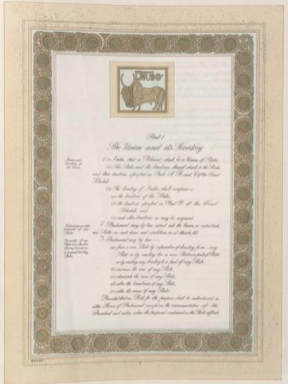
One of the most interesting illustrations can be found on the opening page of the Constitution. It bears a humped bull seal along with the yet undeciphered script of the Harappan civilisation. The illustrator has very consciously placed it there to draw attention to the Indus Valley, where the primaeval civilization of ancient India was birthed. Seals were excavated in this region, standing as symbols of a social, political, and cultural order that has excited since time immemorial. The seal marks the very beginning of the definition of civilization that has been passed down the line to the contemporary era.
4. Part II - Scene from Vedic Ashram (Gurukul)
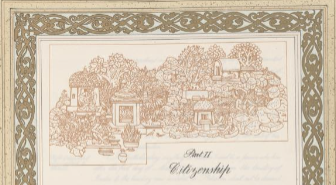
The Gurukul system has been an integral part of the Indic education system. Part II of the Constitution, which deals with citizenship, opens with the illustration of an ashram bearing four ascetic figures offering prayers and performing yajnas. The performance of the yajna symbolically stands for the commencement. The background features the lush green forest surrounding the hermitage. The yogis can be seen in their distinctive attire, with their tied buns and long beards; they are the bearers of knowledge and wisdom from the Vedas. Alongside them are uncaged animals. All in all, a harmonious, peaceful coexistence is brought to the limelight. This encapsulates the idea that for a nation to thrive, citizens need to live a conscious life, without causing any disruption in the natural order.
5. Part III - A scene from Ramayana
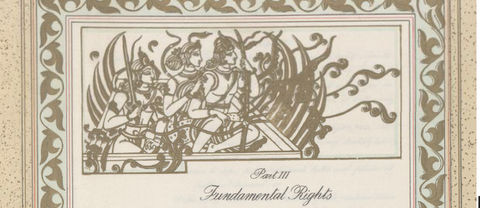
The holy triad after the conquest of Lanka and recovery of Sita.
The beginning of Part III, which discusses fundamental rights, features a scene from the Ramayana. This scene portrays Shri Ram, Devi Sita, and Shri Lakshman seated on the Pushpak Vimana, returning to Ayodhya after 14 years of exile and victory over the notorious Ravan, known for his malicious deeds. This depiction holds certain implications. Firstly, it signifies the triumph of Dharma over Adharma, representing the victory of good over corrupt. Secondly, it also underscores the importance of diligently carrying out one's assigned duties in a manner aligned to one’s principles.
6. Part IV - A scene from Mahabharata
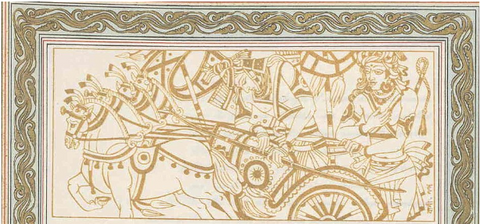
Sri Krishna propounding Gita to Arjun
The Bhagavad Gita is revered as part of the Mahabharata epic. This enduring narrative continues to hold relevance in present times for its timeless philosophies. In Part IV of the Indian Constitution, which delves into the Directive Principles of State Policy, a poignant analogy can be drawn. An armoured Arjuna is distressed by the idea of killing, even of his dear ones. Holding the reins with calm eyes and pointing one hand to himself is Krishna, who implores him to perform his duties and leave the chaos to him. Krishna talks of the principles of detachment, acceptance, impermanence, and righteousness. Essentially, the illustrator might want to convey that, for the greater good, the state has to undertake certain actions guided by stoicism.
7. Part V - A scene from Buddha’s life.

In Part V of the Constitution, which addresses the conduct of the President and Vice President, there is a depiction of Buddha in his enlightened state, surrounded by his disciples, trailblazing his first sermon. This portrayal symbolises Buddha's awakening, representing a transition into a higher state of consciousness. It serves as a subtle suggestion that the Union government, including its key components such as the Executive, the Legislature, and the Judiciary, should aspire to embody the enlightened ideals epitomised by Buddha's wisdom and consciousness.
8. Part VI - A scene from Mahavir’s life
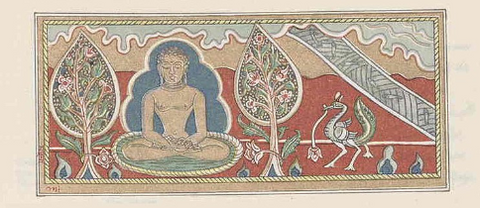
Mahavira- The 24th trithankara of Jainism
The next part which deals with the functions and powers of States has the image of Vardhamana Mahavira, the 24th Trithankara in a meditative posture. It is one of the few coloured images in the constitution. We all know that Mahavira was known for his non-violence or Ahimsa. This representation is likely encouraging the states to follow the path of non-violence while executing their powers.
9. Part VII - Scene depicting spread of Buddhism by Emperor Ashoka
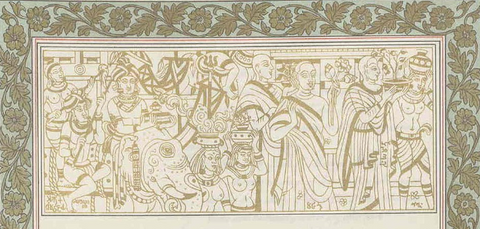
Bedecked Emperor Ashoka with Buddhist Monks
The spread of Buddhism's teachings would not have been possible without King Ashoka.He actively sent Buddhist monks to various regions, including modern-day Sri Lanka, Macedonia, Egypt and Tibet. King Ashoka's influence is deeply ingrained in the Republic of India, symbolised by the Lion Capital and the Wheel of Dharma.The Republic of India seeks to integrate elements from one of South Asia's largest empires, drawing inspiration from Ashoka's legacy to promote values of harmony and equality. The painting is made in a typical Ajanta-like fashion, as visible in the depiction of their bare chest and jewellery. King Ashoka is depicted riding a bejewelled elephant, surrounded by his entourage.
10. Part VIII - A bejewelled gandharva
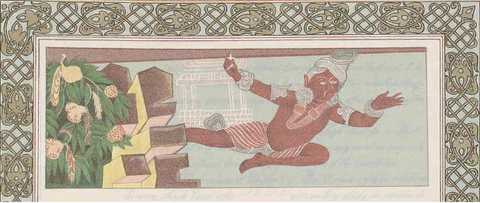
Gandharvas are mythical figures in Hindu pantheon, serving as messengers between gods and humans. The bejewelled Gandharva, depicted in his typical pose, marks the opening of Part VIII of the Constitution.
11. Part IX - A scene from King Vikramaditya’s court
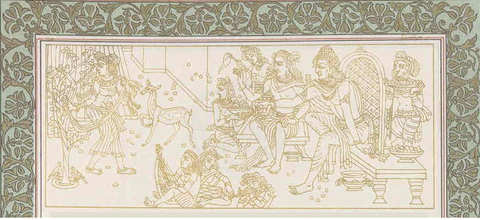
Emperor of Ujjain- King Vikramaditya
Emperor Vikramaditya, one of the central figures found in the ancient Indian literature, is depicted in Part 9 of the Constitution.. He can be seen seated on a majestic throne, surrounded by an entourage comprising of singers, dancers and animals engaged in a rhythmic ecstacy. Renowned for his governance, tolereance towards diverse beliefs, and his passion for art and literature, Vikramaditya is considered as an epitome of good governance.
12. Part X - Dharma Chakra

An emblem bearing Ashoka Chakra
We have yet another tribute to the Ashokan empire. Part X depicts an emblem. While one section of it depicts two deers seated beside the Dharma Chakra or the Ashoka Chakra, the other half of it seems to bear a poignant slogan on Nalanda.
13. Part X - Scene depicting Nalanda University

From the mathematical genius of Aryabhata to the literary outpouring of Kalidasa, the Gupta period is often regarded as the renaissance period of India. The country is said to have contributed to 25 percent of the world GDP during this era. It was during this time that Nalanda Mahavihara, one of the finest universities in the world, emerged. This ancient centre of learning, which thrived in the city of Rajagriha (present-day Rajgir), boasted some of the most revered scholars of Mahayana Buddhism. Today, it stands as a designated World Heritage Site.
14. Part XI - Scene from Orrisian sculpture

Part XI of the Constitution features an exquisite composition that pays tribute to the ingenuity of the amazing artists of Orissa showcasing a warhorse horse trampling a man who is armed with a dagger as a man stands next to the horse. This representation was 1st found in the architectural carving of the 13th-century temple dedicated to the Sun God in Konark. Here, Nandalal Bose envisions a man from the 13th century and takes the creative liberty of restoring to a figure that was severed.
15. Part XII - Image of Natraj

Natraj in the gajahasta position
In Part XII, a noticeable transition unfolds from ancient to early mediaeval times, marked by the inclusion of grand Chola bronze sculptures in our Constitution. Here, a magnificent depiction of Natraj takes centre stage. Natraj is a widely known symbol of Indian culture. Natraj is surrounded by a ring of fire, he is Shiva in one of his cosmic dance forms, known as Tandav. Shiva, the destroyer of ignorance or ego, holds Agni (fire) in his left backhand and an instrument, possibly, Udukai, in the other. One front hand is in gajahasta (elephant hand)or dandahasta (stick hand) mudra, while the other, intwined with a snake, form the abhaya mudra-imploring his devotees to be brave. This iconic figure of Natraj has also been featured at the G20 summit, underscoring its quintessential representation of Indianness.
16. Part XIII - Scene from Mahabalipuram Sculptures (Bhagirath’s penance and Ganga descent)

The story of Ganga Avataran
Ganga Avataran, or the descent of the Ganga in Part XIII, is replete with multiple components. From Kaliya, the serpent, to Ganas, Apsaras, and other creatures, they come together in the panel to depict the story of Ganga Avataran. It depicts the penance of Bhagirath, who played an important role in the rise of river Ganga. The illustrator has highlighted the importance of the river. In this context, the Ganga River is not just limited to legends but is an active source of life. It represents all rivers and seas, contributing to the flourishing of various trade and commercial activities leading to economic growth.
17. Portrait XIV - Portrait of Akbar with Mughal Architecture
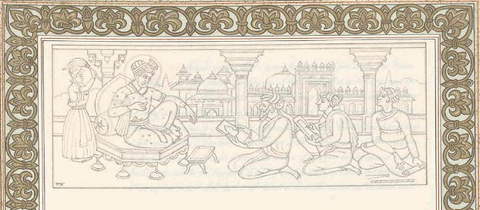
Mughal Emperor Akbar seated on his throne
Part XIV of the Constitution of India, consists of articles on services under the Union and States.The Mughal Empire left an indelible mark on India during its 225-year presence, marked by battles, alliances, the emergence of new arts and architecture, and various other activities. The roots of revenue administration are believed to be traced back to the Khilji empire. The pictorial art illustrating Akbar's court and his administrative duties seems to mirror the provisions of the Constitution. One can see the typical Mughal architecture, as was prominent during the reign of Akbar, such as the tall gateways.
18. Part XV - Portraits of Shivaji and Guru Gobind Singh

The founder of Marathta Empire- Shivaji and Sikh leader- Guru Gobind Singh
While Shivaji is celebrated for his heroism and indomitable spirit, Guru Gobind Singh Ji, the last Sikh Guru, is renowned as the founding figure of the valorous Sikh warrior community. In Part XV of the constitution, dedicated to the essence of democracy and elections, these two historical leaders are portrayed with daggers, swords, and crowns held high.
19. Part XVI - Portraits of Rani Laxmi Bai and Tipu Sultan
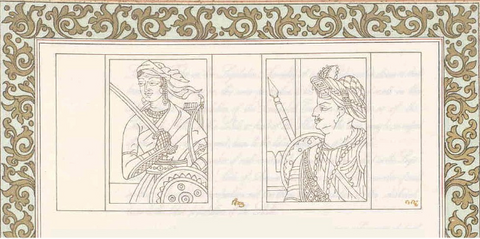
Portraits of Rani Laxmi Bai and Tipu Sultan
Part XVI continues to honour freedom fighters, showcasing the courageous Rani Laxmi Bai in her richly adorned warrior attire alongside the king of Mysore, Tipu Sultan, commonly referred to as Sher-e-Mysore/ Tiger of Mysore. This is one of the only two depictions of women in the Indian constitution, the other being of Sita.
20. Part XVII - Gandhi’s Dandi March
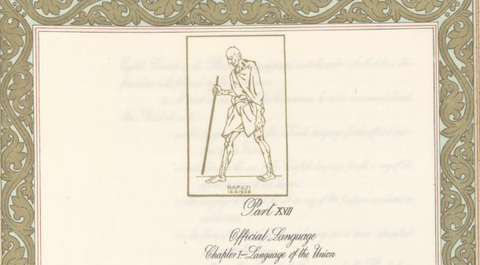
Depiction of Mahatama Gandhi during the Dandi March
The independence movement was filled with numerous trials and significant social events. Mahatma Gandhi's iconic struggle against the British administration is widely acknowledged. Clad in simple attire, barefoot, with visible sinews, the image in Part XVII vividly represents his famous Dandi March, also known as the Salt Satyagraha, protesting against the unjust taxes on salt. The image is captioned with the date on which the Satyagraha began - 12th of April, 1930.
21. Part XVIII - Bapuji the Peace Maker- his tour in the riot affected areas of Noakhali

Gandhi is seen visiting a humble house.
This image, found in Part XVIII of the constitution addressing Emergency Provisions, captures a pivotal moment during Gandhi's visit to the riot-hit Noakhali in Southeast Bangladesh after the independence of our country. The scene opens in an informal village setup, where he is graciously welcomed by a woman holding an aarti thali. This portrayal of Gandhi assuming the responsibility of visiting a state in chaos serves as a reflection of the theme of Part XVIII, which delves into security measures, provisions, and official statements concerning states grappling with disturbances.
22. Part XIX - Netaji Bose and other patriots trying to liberate Mother India from outside India
Netaji and his fellow patriots
Netaji was a revolutionary leader who boldly confronted the British army in defiance of brutal colonial rule. A contemporary of Mohandas Gandhi, he is depicted alongside his armed retinue. Dressed immaculately and formally, he stands tall, pride evident in his eyes as he salutes the flag. Netaji played a key role in the formation of the Indian army, which also included the first only-women regiment.
23. Part XX - The scene from Himalayas

This scene serves as a symbol of the diverse and rich geography of India. The Himalayas not only boast rich biodiversity but also stand as the tallest mountain range of the planet. The muted shades capture the natural beauty of the snowy Himalayas depicted in this setting. The Himalayas act as a natural boundary in the North of India.
24. Part XXI - Scene of the Desert

Part XXI captures the scene from the arid hot desert of Rajasthan. The centre stage is taken by a decked camel - also known as the ship of the desert. It depicts the entire entourage of a leader, perhaps a king, as suggested by the flag. Followed along by the members of his community or the army.
25. Part XXII - Scene of the Ocean
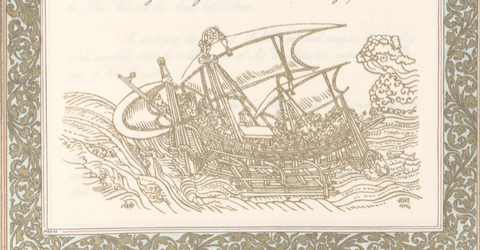
A scene of the Indian Sea is sketched in the last section of the Constitution that mentions the commencement and repeal. Waterways have been a prominent mode of transportation since the Indus Valley Civilization, and have been used by people from across the world to reach mainland India. India has a vast coastline, which gives it access to three different water bodies - the Arabian sea, the Bay of Bengal and the Indian ocean. This image depicts the turbulent nature of the water bodies, which require a certain amount of skills to cross.
Back cover of the constitution

Lastly, I want to conclude by highlighting the simple yet sophisticated black cover. The back cover of this document is adorned with a golden wreath of flowers set against a striking black background. This elegant design, invariably, adds a touch of sophistication to our book of Constitution.
Did you know that there are three original of the Constitution of India, all preserved in the Central Library of the Parliament? To view them one must pass through a security enclosure consisting of three rooms.
References:
M, Chandrakala. “Painting Illustrations of the Indian Constitution.” INDIC INSPIRATIONS, July 20, 2022. https://blog.indicinspirations.com/painting-illustrations-of-the-indian-constitution/.
“The Constitution of India (Original Calligraphed and Illuminated Version)/Part 14/Chapter 1.” Wikisource, the free online library. Accessed January 23, 2024. https://en.wikisource.org/wiki/The_Constitution_of_India_(Original_Calligraphed_and_Illuminated_Version)/Part_14/Chapter_1.
Chaudhry, Garima. “Constitution of India - 22 Paintings: An Ode to Indian Culture and History - Cultural Samvaad: Indian Culture and Heritage.” Cultural Samvaad| Indian Culture and Heritage, May 12, 2023. https://culturalsamvaad.com/constitution-of-india-22-paintings-ode-to-indian-culture-and-history/.
“The Constitution of India.” Library of Congress. Accessed January 22, 2024. https://www.loc.gov/resource/llscd.57026883/?sp=1.
O’Brien, Barbara. “What Are the Four Noble Truths of Buddhism?” Learn Religions, April 23, 2019. https://www.learnreligions.com/the-four-noble-truths-450095.
“National Emblem of India: An Overview.” Chegg India, January 12, 2024. https://www.cheggindia.com/general-knowledge/national-emblem-of-india/#:~:text=India%E2%80%99s%20Ashoka%20Chakra%2C%20derived%20from%20ancient%20sculpture%2C%20symbolizes,progress.%20This%20symbol%20unites%20people%20across%20diverse%20backgrounds.
The Heritage Lab. “Republic of Art: The Constitution as an Illustrated History of India.” The Heritage Lab, January 30, 2023. https://www.theheritagelab.in/constitution-india-art/.



